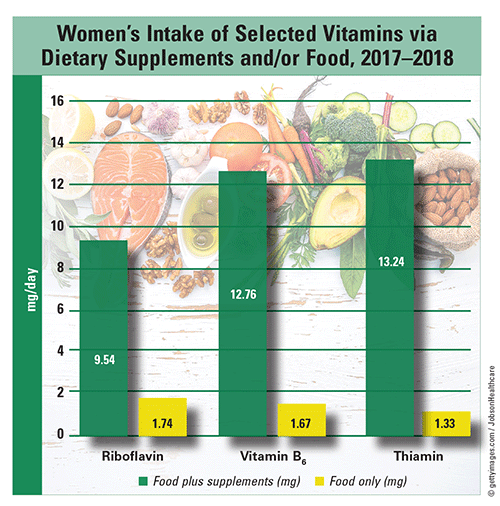US Pharm. 2021;46(9):14.

In 2020, according to the National Health and Nutrition Examination Survey, 77% of adult females used dietary supplements. Women obtained 1.89 mg and 10.87 mg of vitamin B6 daily from foods and beverages (henceforth referred to as “food”) and supplements, respectively. When intake was calculated by age group, women aged 20 to 39 years had the highest consumption of vitamin B6 from both food (2.24 mg) and supplements (13.58 mg). Women aged 60 years and older took the highest amount of niacin supplements (52.2 mg) and consumed the greatest quantity of niacin overall (71.5 mg). Supplements provided three to four times more riboflavin than that obtained from food. Regarding thiamin, food provided about 10% of what supplements provided.
Fatty Acids: The U.S. Department of Agriculture found that women aged 30 to 39 years consumed 5%, 9.5%, 2.2%, and 3.6% less total fat, saturated fat, monounsaturated fat, and polyunsaturated fat, respectively, than women aged 20 to 29 years. Similarly, women aged 50 to 59 years consumed 7.8%, 7.3%, 5.6%, and 12.4% less total fat, saturated fat, monounsaturated fat, and polyunsaturated fat, respectively, than women aged 40 to 49 years. Among women aged 70 years and older, the consumption of all types of fatty acids was significantly lower than in younger women.
Vitamins: Women of all ages obtained large quantities of nutrients from food, although in certain instances they consumed less than the Recommended Dietary Allowance (RDA). Daily intake of riboflavin from food (1.8 mg) was 63.6% greater than the RDA (1.1 mg). Intake of niacin, vitamin B6, and vitamin C was similar, with women consuming 51.4%, 33.8%, and 11.5%, respectively, over the RDA (14 mg, 1.3 mg, and 65 mg, respectively). However, for choline and vitamin E (alpha-tocopherol), women obtained only 66.1% (281 mg) and 57.3% (8.6 mg) respectively, of the RDA (choline, 425 mg; vitamin E, 15 mg) from food.
Protein, Fiber, and Unsaturated Fat: Consumption of foods containing protein, dietary fiber, monounsaturated fat, and polyunsaturated fat was highest in women aged 20 to 29 years. Of these macronutrients, protein had the highest intake (73.8 g daily), but its consumption decreased to 69.5 g among women aged 30 to 69 years. In the same age group, intake of dietary fiber and monounsaturated fat was an average of 15.3 g and 26 g, respectively. Intake of protein, dietary fiber, monounsaturated fat, and polyunsaturated fat from food declined with age, being 10% to 15% lower in women aged 70 years and older.
The content contained in this article is for informational purposes only. The content is not intended to be a substitute for professional advice. Reliance on any information provided in this article is solely at your own risk.
To comment on this article, contact rdavidson@uspharmacist.com.






